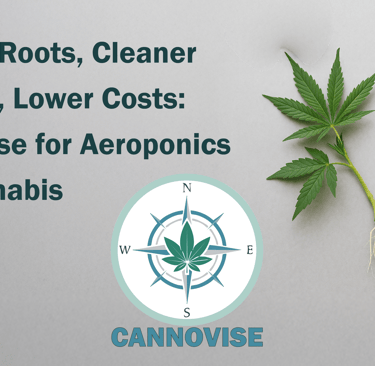Faster Roots, Cleaner Rooms, Lower Costs: The Case for Aeroponics in Cannabis
William Kanistras
7/29/20255 min read


Cloning is the foundation of every successful cannabis operation. It is where uniformity begins and where every grow cycle is first won or lost. If your propagation process is inconsistent, wasteful, or labor-heavy, you are paying for it at every stage that follows. Aeroponic cloning offers a more sustainable and efficient path forward. It does not just reduce costs and improve rooting speeds. It fundamentally changes how propagation fits into the broader ecosystem of your farm.
I have been using aeroponic systems to root plants for over 20 years. I still run them in my current grows, and I have built entire production cycles around them because they work. The process is faster, cleaner, and more consistent than any other method I have used. I do not say that lightly. I have run soil, rockwool, peat, and every kind of plug system over the years. Aeroponics continues to outperform across the board.
For cultivators trying to increase throughput, stabilize quality, and reduce environmental impact, the shift to aeroponics is not just smart. It is strategic.
What Is Aeroponic Cloning?
Aeroponic cloning is a propagation method where plant cuttings are suspended in open air and regularly misted with a fine spray of nutrient-rich water. The stems are kept moist in a highly oxygenated environment, encouraging fast and healthy root development without the use of soil or growing media.
Unlike soil-based or plug-based cloning methods, there is no substrate for roots to fight through. There are no peat pods, no rockwool cubes, and no domes stacked across racks. Instead, you have a clean, controlled rooting environment that promotes speed, consistency, and minimal waste.
If you have ever had a room full of domes and humidity swings, you know the struggle. With aeroponics, you eliminate most of that guesswork. Your root zone is always hydrated, always oxygenated, and always consistent from batch to batch.
Why It Matters for Cannabis Cultivators
Propagation is not just about getting roots. It is about getting uniform starts with minimal loss, minimal effort, and minimal waste. In cannabis, where timing is everything and consistency is king, the propagation method you choose can define your ability to scale, automate, and comply with increasingly strict environmental and business regulations.
Aeroponics answers that call on every level. The systems can be small enough for a hobbyist or scaled large enough for commercial nurseries producing thousands of cuts a week. I’ve done both. I’ve built compact setups for lean personal production, and I’ve supported full-size propagation rooms that ran almost entirely on aeroponic systems.
Cleaner Inputs, Less Waste, Smaller Footprint
One of the biggest advantages of aeroponic cloning is how little it requires to do its job. Most growers do not realize how much waste is created in traditional cloning rooms. Between plastic inserts, rockwool, disposable trays, and packaging from nutrient jugs and rooting gels, a single propagation cycle can generate piles of landfill-bound trash.
Aeroponics eliminates nearly all of it. There is no growing media. There are no single-use trays or liners. There is no daily runoff heading into drains or surrounding soil. A well-designed aeroponic system recirculates water, meaning you use a fraction of the nutrients and almost none of the water that conventional setups burn through. There is also far less evaporation.
From an environmental perspective, this is one of the cleanest propagation models available. From a compliance perspective, especially in water-restricted or environmentally sensitive regions, this can make the difference between a scalable operation and a regulatory headache.
The impact is real. I have tracked my own water and input use closely. With aeroponics, I consistently run cleaner rooms with fewer material orders, fewer empty boxes, and almost no disposable media ending up in the trash. It makes compliance easier and makes environmental responsibility something you can measure.
Faster Rooting with Better Transplant Performance
Time is money, especially when every square foot of cultivation space is budgeted against output. Aeroponic clones consistently root faster than those grown in soil or plugs. Many growers report root formation in five to seven days, with visible root mass by day ten. Compared to the ten to fourteen days typically needed for rockwool or peat, you are looking at a four-to-seven-day advantage per batch.
Multiply that by how many cycles you run per year, and you are creating room for an additional harvest or a longer veg run without increasing your footprint. The clones also tend to develop more fibrous, high-oxygen roots. That means less transplant shock, stronger early-stage growth, and fewer slow starts.
I have seen it firsthand over and over again. My aeroponic clones hit transplant stronger and bounce back faster. They uptake nutrients more efficiently and hold structure better in early veg. For anyone running a tight calendar or a lean veg room, this matters more than most people realize.
Labor Savings You Can Measure
Anyone who has run a clone room knows the time suck that comes with media prep, dome management, hand watering, tray sterilization, and transplanting. These tasks are repetitive, time-consuming, and often performed by your highest-turnover staff.
Aeroponic systems dramatically reduce the need for daily intervention. Once the system is charged and cuttings are placed, there is no need for watering or misting. The system handles hydration automatically. You do not have to lift domes, you do not have to monitor cube saturation, and you are not constantly prepping new trays.
I have been able to run full clone rooms on a skeleton crew because aeroponics frees up labor. You focus less on maintaining trays and more on planning production. Instead of managing wet plugs and dome fog, your staff can focus on health checks, root inspections, and timing the transplant window accurately. It keeps the work clean and straightforward.
Cost Savings That Scale Over Time
Aeroponic cloners cost more up front. That is true. But over time, they pay for themselves several times over. When you stop buying rockwool or coco plugs every week, and you reduce your water and nutrient use, the numbers flip.
Even if you are saving only one dollar per clone, which is conservative, that adds up fast. In a 1k-site system running multiple times per month, you are saving thousands over the course of a season. Add in labor reductions, reduced transplant loss, and lower material handling costs, and you are looking at a major shift in how efficient your propagation system can be. More cuts rooted, fewer thrown away, fewer inputs bought, and less money spent on labor to manage it all.
Built for Consistency and Compliance
Cloning is one of those processes where every variable matters. Temperature, humidity, light intensity, media saturation, and air circulation all influence rooting success. With traditional methods, those factors shift constantly depending on how the media holds water, how often domes are opened, and how skilled the person is who prepped the tray.
Aeroponics brings consistency. With a stable system, you can dial in rooting conditions and replicate them every batch. That predictability is worth its weight in gold, especially when supplying clone contracts or coordinating with flowering schedules across multiple rooms.
The compliance benefits are also appealing and cost-saving. Less waste, fewer chemical inputs, no media to dispose of. That makes it easier to pass inspections, track inputs, and align with environmental regulations that only continue to tighten. If you are looking ahead to long-term licensing and state-level sustainability mandates, aeroponics puts you out in front before the rules change.
The Takeaway
Aeroponic cloning is not new. It is not unproven. I have been running these systems for over two decades, and they continue to deliver reliable, high-quality results. What has changed is the pressure on growers to do more with less. Less waste, less labor, less time, and fewer resources to get the job done.
Aeroponics answers all of that with a system that saves time, saves money, and supports better plants with fewer headaches. It is not about being high-tech for the sake of it. It is about getting consistent performance from your propagation cycle while staying lean, compliant, and sustainable.
At Cannovise, we support growers building systems that work. Aeroponics is one of them. If you are tired of juggling domes, plugs, and plastic trays, or if you are trying to get your margins under control without cutting corners, this is where I would start.
Your partner in cannabis compliance and operations.
info@cannovise.com
© 2025. All rights reserved.
